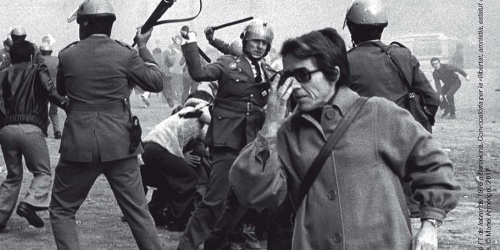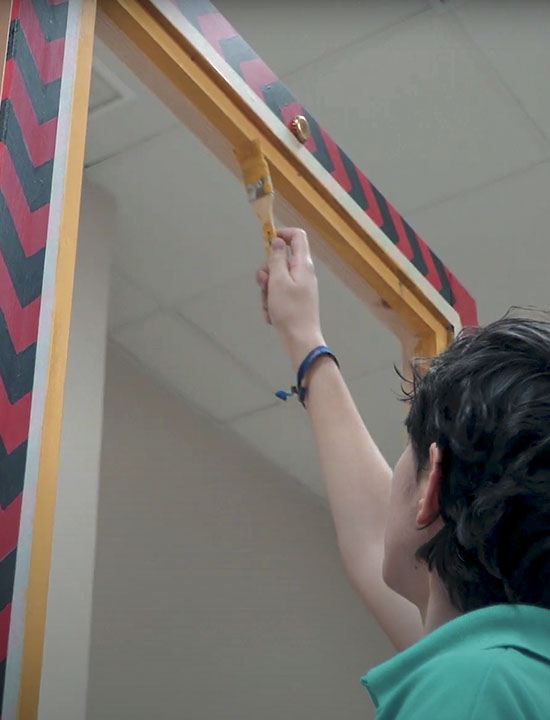Search
Loving couple. Project for a fan
Read more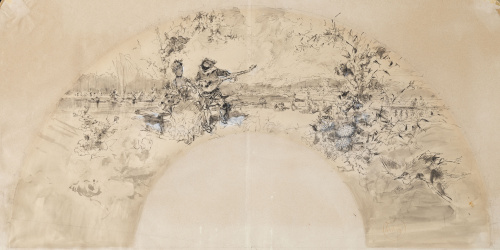
I. The Rise of the Modern Artist
One of the ways in which the modern artist defends his independence from academic norms is through realism, understood as an unidealised description of the world. The nude being the culmination of academic apprenticeship, it is hardly surprising that it is also where this move against idealisation shows most. The human body displayed in its most material reality, therefore, went against the abstract canons of beauty represented in the classic nude. The ineluctable objectivity of photography, a new competitor of art in its own terrain, was to have an enormous influence in this realistic vision of the body.
I. The Rise of the Modern Artist
Whereas the landscape took second place under the old hierarchies, in the latter half of the 19th century it became the most important genre in painting. For one, as a byword for realism, and for another, as the image of the freedom of the artist who, having left the enclosed life of the academy, painted unfettered en plein air, ie in the open air. But this is also a terrain in which the competition from photography showed itself in the repetition of subject matter and formal resources... Pictorialism, a photographic movement that sought to ‘elevate’ photography to the category of art, found its chief subject matter in cloud-filled landscapes and backlighting.
Donations and bequests to the Museu Nacional
Planned donations or bequests to the museum
Each day, thousands of children, youths and adults are enriched by visiting the collections of the museum or attending its activities and exhibitions.
Some of the donations from individuals such as that of Enric Batlló (1914), the Cambó bequest (1949-1954) or that of the Espona bequest (1958) and other more recent ones such as the donation of the collection of Joan Colom (2012) due to the will of the photographer himself, have contributed to forming the collections of the museum as we know it today.
If the Museu Nacional is important to you, you should know that you have the possibility of helping it by means of a donation for the future or by means of the works of art in lieu of payment of taxes.
All the donations, however modest they may be, are important contributions for increasing the collections of the museum, providing support for the exhibitions and their education and social programmes.
We are committed to using your donation in an efficient way, attend to your will, with respect and sensitivity, and recognising it in the most suitable way possible.
If you are interested, please write to [email protected] or call 93 622 03 60.
Donations in micro-patronage projects
The Foundation of the Friends of the Museu Nacional and the Museu Nacional d’Art de Catalunya invite you to form an active part in the funding of certain projects, such as, for example, acquisitions and restorations of works of art. Thanks to a project of this type, the drawing The Prayer , by Marià Fortuny, now forms part of the collections of the Museu Nacional.
Read more
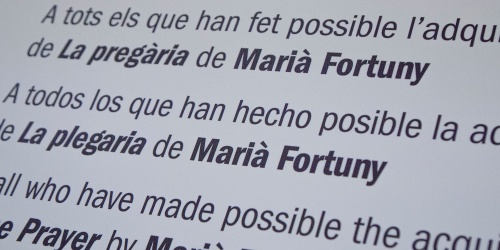
I. The Rise of the Modern Artist
The ‘Orient’ is present in the bourgeois art and culture of the second half of the 19th century for two reasons. First, its discovery coincided with the imperialist campaigns of the European powers, who violently reduced the countries of north Africa to the level of colonies; secondly, for the European imaginary, a fantastic ‘Orient’ that was very different from the real thing became the place where passion, now lost in the vulgarisation of the metropolis, was still possible. Orientalism, in short, filled with consoling dreams, became one of the most commercial subjects of the new art markets.
I. The Rise of the Modern Artist
In the hierarchies of art, historical painting has occupied the highest position. These were large-format works with many characters, which earned the artist his greatest recognition. But in an artistic world that was no longer dominated by the symbolism of the ancien régime, so much as by the fickleness of the market and the fleeting present, there was no longer room for those great ‘moralising machines’. Driven by the advent of journalism and photography and the need to preserve his status in face of these new media, the modern artist replaced historical themes with current affairs issues: the colonial war, the class struggle, etc.
I. The Rise of the Modern Artist
At the end of the 19th century, when Japan opened its doors to trade with the West, interest in its culture and art spread rapidly through European society. In particular, the popular prints of the type known as ukiyo-e became objects of admiration, both for the bourgeoisie and for artists themselves. Bourgeois interiors filled with Japanese ornaments –printed cloths, screens, sunshades, fans...–, but unlike what had happened with other superficially assimilated exoticisms, the style of these prints –the line, the flat colours, the framing and formats– was to be decisive in structuring the aesthetics of the avant-gardes.
Obrint portes: an Arts&Health project
"If opportunity doesn't knock, build a door."
EDU
"The arts can help us to emotionally manage the processes of fighting an illness or injury, to process difficult emotions in times of emergency, and face challenges.
Both the creation and enjoyment of the arts contribute to promoting comprehensive well-being, and can be a motivating factor in recovery.
Benefits are evidenced through various indicators, including health promotion, management of health conditions and disease prevention."
WORLD HEALTH ORGANISATION
“Obrint portes” is an arts in health project developed by the Hospital Universitari Vall d’Hebron and the Museu Nacional d’Art de Catalunya, within the framework of the Arts+Health HUB-LAB of the MNAC, a permanent space for hosting and generating activities and research projects in the field of arts and health.
“Obrint portes” aims to improve the emotional well-being and enhance the socialisation of a group of young people who have experienced an oncological process. Art becomes a space to share and express yourself, based on observation, dialogue and creation.
The project forms part of a research study that assesses the impact on health in the group of participants, which will allow broadening the evidence base of the potential of the arts in improving people's health and identify tools and therapeutic strategies based on art.
Watch the full video on the YouTube channel by clicking here.
These questions were the driving force behind a flurry of ideas and concepts, distilled into a single word that proposed specific materials, shapes, textures and colours. Within the framework of the intervention protocol defined by the Hospital Universitari Vall d’Hebron, the programme designed by the MNAC team revolves around the symbolism of doors, such as those that can be found in the modernist furniture collection of the MNAC or in pictorial works by Feliu Elies or Marià Fortuny.
Once the project was defined in sketches, the creative process of the boys and girls incorporated various artistic mediation resources, such as the Visual Thinking Strategies (VTS), which encourage dialogue and communication through the observation of the art, and which have had the support of the Museum's technical teams, such as infrastructure, preventive conservation and carpentry.
Thus, starting with bare doors, the hands of the boys and girls transformed them until they became the works of art that we present in this exhibition space. Works of art full of meaning that come to life.
“Obrint portes” also wanted to take into account the families, who experience the disease process first hand and as caregivers. Throughout the various sessions, they have been able to enjoy a space where they can meet other parents who are going through similar experiences. They have discovered the Museum as a space for enjoyment, recreation, conversation, disconnection and, at the same time, connection with the deepest emotions. In short, they have found a place of care and generator of well-being.

Opening doors. Arts in health at the MNAC
- They do so through the ‘Opening Doors’ arts in health programme ...
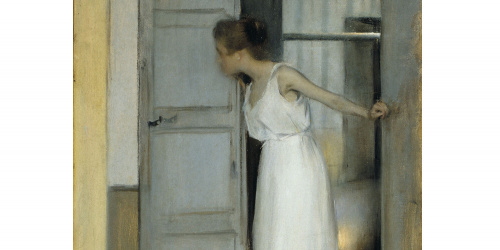
Uprisings
Read more